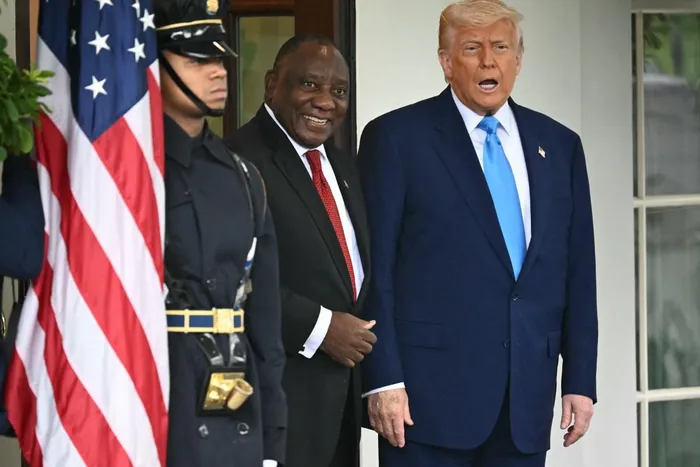Surfing the Trump tsunami: how tariffs are rocking, but not sinking South Africa
TARIFFS

Import tariffs by the United States could still be reconsidered, following direct communication between President Cyril Ramaphosa and US President Donald Trump.
Image: Mandel NGAN / AFP
When Donald Trump announced sweeping new tariffs earlier this year, the move was likened to an economic tsunami, a force capable of shaking global trade foundations.
Yet, much like the massive earthquake off Russia’s Kamchatka Peninsula that triggered Pacific tsunami warnings but caused minimal damage, the initial economic shock has not yet unleashed the devastation many feared.
“It is too soon to tell, but so far economic activity inside and outside the US has held up surprisingly well,” said Izak Odendaal, Old Mutual Wealth Investment Strategist.
“Global equity markets are on track for a decent year despite the considerable uncertainty,” Odendaal addded.
Global resilience has been buoyed by factors such as stockpiling ahead of tariff deadlines, rate cuts by central banks outside the US, and a weaker dollar that has lowered import costs.
In the US, steady credit conditions, loose fiscal policy, and surging AI-related investment have also provided a cushion.
However, Odendaal warned that the reprieve may be temporary.
“One of the risks is that Trump feels emboldened to push tariffs further. We’ve already seen steep tariffs on countries like India and Brazil for reasons that seem more political than economic,” he said.
South Africa moves to protect US market access
The challenge for South Africa is direct: 30% tariffs now apply to key exports bound for the US.
On Tuesday last week, the government submitted a revised trade offer to Washington in an effort to ease the blow.
Trade, Industry and Competition Minister Parks Tau, alongside Agriculture Minister John Steenhuisen, described the offer as “broad, generous and open”, aimed squarely at meeting US demands outlined in its 2025 National Trade Estimates Report.
“This is a broad, generous and open offer that I think meets the ambition criteria. If you look at it from a trade and tariff perspective, it represents something that will be good for the US and also for South Africa,” Steenhuisen said.”
The offer addressed sanitary and phytosanitary measures for poultry, blueberries, and pork, with the first shipment of US meat products expected in South Africa shortly.
Officials hope this will allow the US to fully utilise the 72 000-ton Tariff Rate Quota agreed in 2016.
A high-level team from the dtic and Agriculture Department is now set to engage Washington in “mutually beneficial” talks.
“Our goal is to demonstrate that South African exports do not pose a threat to US industries,” the ministers said.
“While the US is our 3rd largest trading partner after the EU and China, South Africa is only the 43rd export destination for the United States, accounting for just 0.25% of total US imports.”
The US market represents about 4% of South Africa’s total agricultural exports, or R9.8 billion, more than double the value in 2018.
“The government is going to do everything possible to keep the American market open for our goods,” Tau stressed.
“At the same time, we are accelerating our efforts to diversify markets across Africa, Asia, the Middle East, and Europe. This is not a plan B; it is a plan A for long-term resilience and competitiveness.”
Business warns of deeper risks
The South African Chamber of Commerce and Industry (Sacci) has warned that the 30% tariff poses a serious threat to the economy and to long-term trade relations with the US.
The chamber highlighted the risk of ripple effects beyond just export volumes, particularly in sectors such as automotive manufacturing, prepared foodstuffs, and precious metals.
“Given that exports account for about 32% of our GDP, and that the US took 7% of total merchandise exports in the first half of 2025, these measures are not something South Africa can absorb lightly,” Sacci said.
The IMF has forecast South Africa’s economic growth at just 1% in 2025 and 1.3% in 2026, in line with the Reserve Bank’s own subdued outlook.
Sacci emphasised that stability and predictable trade policy are essential to preserving investor confidence and ensuring that existing trade surpluses, such as the R4.9 billion recorded with the US in the first half of 2025, are not eroded.
Although business confidence has risen, supported by stronger vehicle sales, manufacturing output, and higher gold and platinum prices, Sacci warned that “the downside risks of potential or real higher trade tariffs to the economy, elevated uncertainty, and geopolitical tensions” could undermine those gains.
Tariffs hit but offsets remain
For now, economists have cut South Africa’s 2025 GDP growth forecast from 1.8% to around 1%. While that is still higher than the past two years, it reflects the headwinds.
Offsets include the Reserve Bank’s 1.25 percentage point repo rate cut over the past year, lower inflation at 3%, and falling fuel prices. Platinum and palladium prices have jumped 45% and 25% respectively since January, supporting the rand and boosting corporate tax revenues.
Despite these positives, Odendaal cautioned that the long-term outcome hinges on political stability in trade policy.
“The longer tariff levels jump around, the more difficult it is for businesses to plan,” he said.
“Eventually the US will probably return to a more pragmatic trade policy, especially if American consumers face higher prices and less choice.”
The irony, Odendaal noted, is that markets have remained unexpectedly buoyant despite the tariffs. The rand has strengthened against the dollar, the FTSE/JSE All Share Index has hit a record 100,000 points, and global equity markets are still in positive territory.
“This is the difficulty with predicting market reactions,” he said.
“Even if you get the big calls right, you can still misread the market’s response. As any surfer will tell you, it’s all about balance. Get your asset mix right, stick to your plan, and ignore the noise.”
BUSINESS REPORT